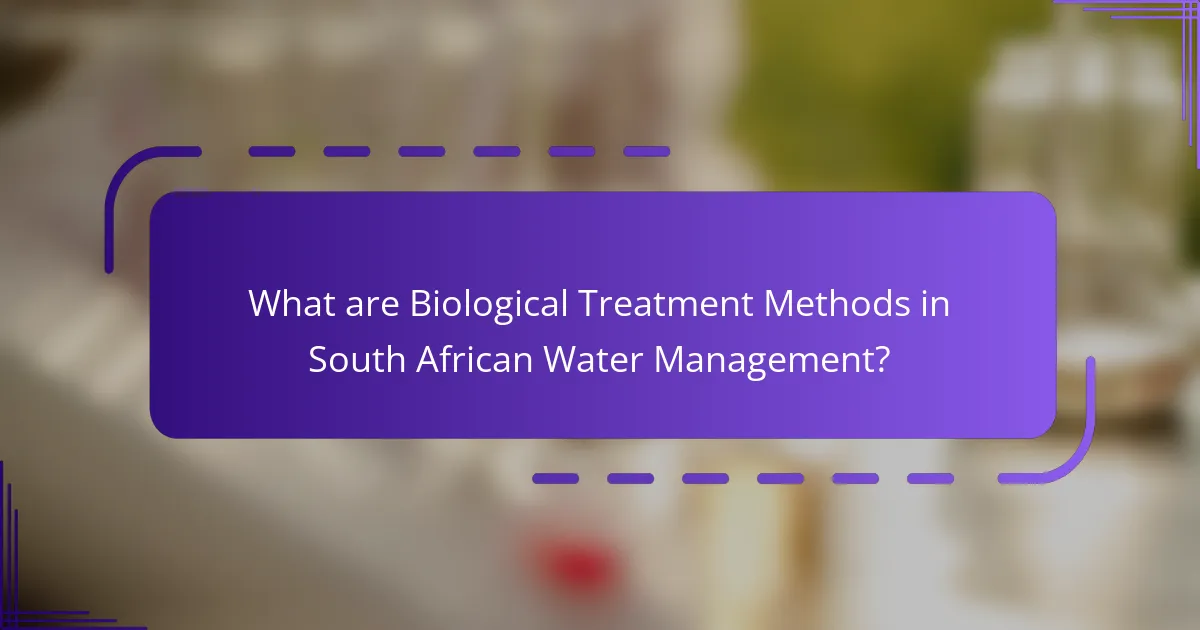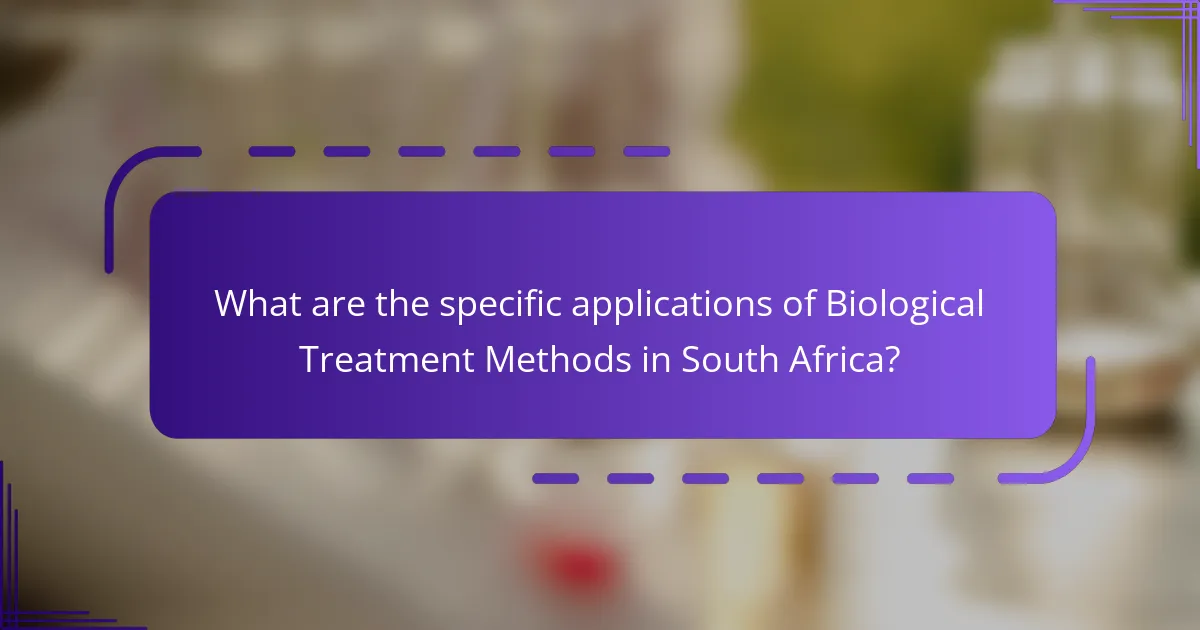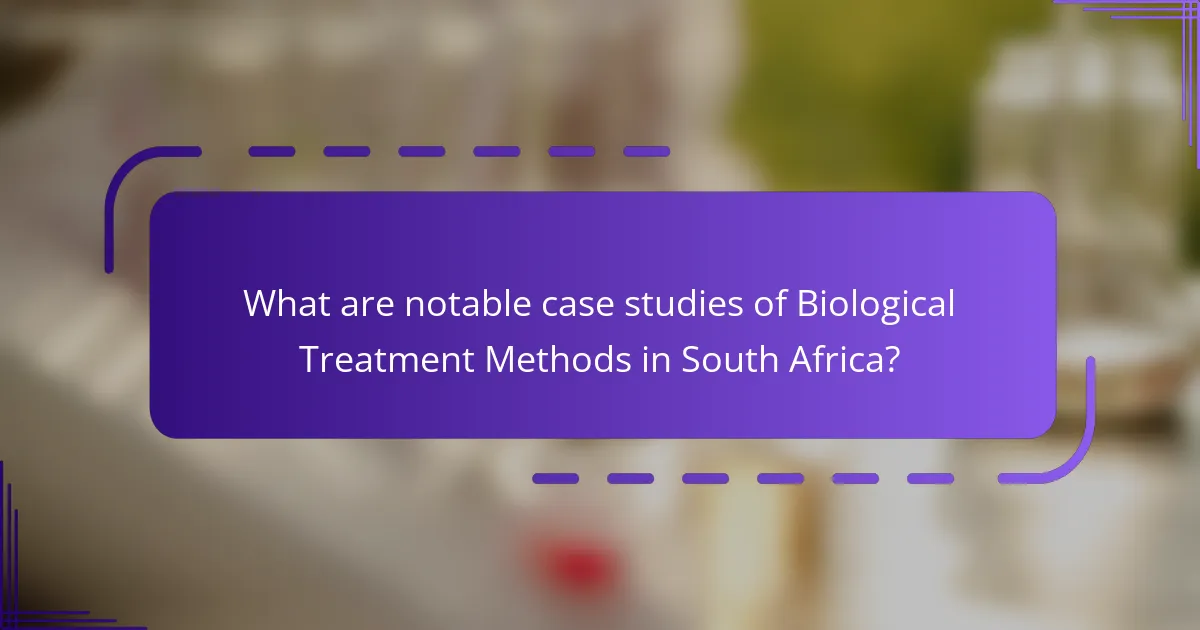Biological treatment methods in South African water management involve the use of living organisms to treat wastewater and enhance water quality. Key processes include activated sludge, biofiltration, and constructed wetlands, which effectively reduce pollutants such as biochemical oxygen demand (BOD) and total suspended solids (TSS). These methods are applied in various sectors, including wastewater treatment, bioremediation of contaminated environments, and sustainable agricultural practices. Notable case studies, such as the implementation of constructed wetlands in Cape Town and anaerobic digestion at the Johannesburg Water Treatment Plant, demonstrate the effectiveness and cost-efficiency of these biological approaches in promoting environmental sustainability and improving water quality across South Africa.

What are Biological Treatment Methods in South African Water Management?
Biological treatment methods in South African water management involve the use of living organisms to treat wastewater and improve water quality. These methods include processes like activated sludge, biofiltration, and constructed wetlands. Activated sludge uses microorganisms to break down organic matter in wastewater. Biofiltration employs filter media to support microbial growth, enhancing pollutant removal. Constructed wetlands mimic natural wetlands to treat water through sedimentation and plant uptake. These methods are effective in reducing contaminants and promoting water reuse. Evidence shows that biological treatment can significantly lower biochemical oxygen demand (BOD) and total suspended solids (TSS) in treated water.
How do Biological Treatment Methods function in water management?
Biological treatment methods function in water management by utilizing microorganisms to break down organic pollutants. These methods enhance the natural decomposition processes in water systems. Microbial communities metabolize contaminants, converting them into harmless byproducts. This process typically occurs in controlled environments, such as activated sludge systems or biofilters.
In South Africa, biological treatment is crucial due to water scarcity and pollution challenges. For instance, the use of constructed wetlands has proven effective in treating wastewater. Studies show that these systems can reduce nutrient levels significantly, improving water quality. Research indicates that biological methods can achieve over 90% removal of certain pollutants. This effectiveness supports sustainable water management practices across the region.
What specific biological processes are utilized in these methods?
Biological treatment methods for South African water management utilize processes such as biodegradation, nitrification, and denitrification. Biodegradation involves microorganisms breaking down organic matter into simpler compounds. This process helps reduce pollutants in water. Nitrification is the conversion of ammonia into nitrate by specific bacteria. This process is essential for removing nitrogen from wastewater. Denitrification follows nitrification and converts nitrate into nitrogen gas. This reduces nutrient loading in water bodies. These processes collectively enhance water quality and promote ecosystem health.
How do microorganisms contribute to the treatment process?
Microorganisms play a crucial role in the treatment process of wastewater. They break down organic matter through metabolic processes. This biological degradation reduces pollutants in the water. Common microorganisms used include bacteria, protozoa, and fungi. These organisms consume nutrients and convert them into energy. In activated sludge systems, bacteria form flocs that settle out of the water. This process clarifies the effluent, making it safer for discharge or reuse. Studies show that biological treatment can remove up to 90% of organic pollutants. Thus, microorganisms are essential for effective wastewater treatment and environmental protection.
What are the key benefits of Biological Treatment Methods?
Biological treatment methods offer several key benefits for water management. They are cost-effective compared to chemical treatment methods. Biological processes utilize natural organisms, reducing the need for expensive chemicals. These methods also promote sustainability by utilizing renewable resources. They can enhance water quality by effectively removing pollutants and pathogens. Additionally, biological treatments can improve the ecological balance of water bodies. Studies show that these methods can lead to significant reductions in biochemical oxygen demand (BOD) levels. For instance, a study by the Water Research Commission of South Africa highlighted a 70% reduction in BOD using biological treatment. Overall, biological treatment methods are an efficient and environmentally friendly solution for water management.
How do these methods improve water quality?
Biological treatment methods improve water quality by utilizing microorganisms to break down pollutants. These methods effectively reduce organic matter, nutrients, and pathogens in water. For example, activated sludge processes enhance the removal of biodegradable organic compounds. Constructed wetlands can filter contaminants while providing habitat for diverse wildlife. Studies show that biological treatments can achieve up to 90% removal of certain contaminants. The use of biofilms in trickling filters also aids in pollutant degradation. Overall, these methods contribute to sustainable water management and ecosystem health.
What environmental advantages do Biological Treatment Methods provide?
Biological treatment methods provide significant environmental advantages such as improved water quality and reduced pollution. These methods utilize microorganisms to break down organic matter and contaminants in wastewater. As a result, they effectively reduce the levels of harmful substances, including nutrients like nitrogen and phosphorus. This process helps prevent eutrophication in water bodies, which can lead to oxygen depletion and harm aquatic life. Additionally, biological treatment methods can enhance the natural biodegradation processes, promoting ecosystem health. Studies show that these methods can achieve up to 90% removal of pollutants, demonstrating their effectiveness in maintaining environmental balance.
What challenges are faced in implementing Biological Treatment Methods?
Implementing Biological Treatment Methods faces several challenges. One major challenge is the variability in wastewater composition. This variability can affect the efficiency of biological processes. Another challenge is the need for specific environmental conditions. For example, temperature and pH must be optimized for microbial activity. Additionally, the presence of toxic substances can inhibit microbial growth. Limited knowledge and expertise in biological treatment technologies can also hinder implementation. Furthermore, there may be financial constraints for infrastructure development. Regulatory compliance and monitoring requirements add complexity to the process. Lastly, public perception and acceptance can impact the adoption of these methods.
What are the common obstacles in technology adoption?
Common obstacles in technology adoption include resistance to change, lack of training, and insufficient resources. Resistance to change often stems from fear of the unknown. Employees may hesitate to adopt new technologies due to comfort with existing practices. Lack of training can hinder effective use of new systems. Without proper education, users may struggle to utilize technology fully. Insufficient resources, such as funding or time, can limit the ability to implement new solutions. According to a study by the World Bank, over 70% of organizations cite resource limitations as a significant barrier to technology adoption. These factors collectively impede the successful integration of new technologies.
How can these challenges be overcome in South Africa?
Implementing integrated biological treatment methods can overcome water management challenges in South Africa. These methods include constructed wetlands and biofilters. They enhance water quality by utilizing natural processes. Constructed wetlands mimic natural wetlands to treat wastewater effectively. Biofilters use microorganisms to remove contaminants from water.
Investment in research and development is crucial. It enables the adaptation of these methods to local conditions. Community involvement in water management promotes sustainable practices. Education on biological treatment benefits raises awareness.
Successful case studies demonstrate their effectiveness. For example, the Grootfontein Agricultural Development Institute utilized constructed wetlands. This project improved water quality while reducing treatment costs. Such initiatives can serve as models for wider application across South Africa.

What are the specific applications of Biological Treatment Methods in South Africa?
Biological treatment methods in South Africa are primarily applied in wastewater treatment, bioremediation, and agricultural practices. In wastewater treatment, these methods utilize microorganisms to decompose organic matter, effectively reducing pollutants. For instance, activated sludge systems are widely used in municipal sewage treatment plants across the country.
Bioremediation involves using biological agents to clean contaminated environments, such as oil spills or heavy metal pollution. This technique has been employed in several industrial sites in South Africa to restore soil and water quality.
Additionally, biological treatment methods are applied in agriculture through composting and biofertilizers. These practices enhance soil health and fertility, contributing to sustainable farming. The South African government supports these applications to promote environmental sustainability and improve water quality.
How are these methods applied in urban water management?
Biological treatment methods are applied in urban water management to enhance water quality and sustainability. These methods utilize microorganisms to decompose organic matter and pollutants in wastewater. For instance, activated sludge processes involve aerating wastewater to promote microbial growth, which effectively reduces biochemical oxygen demand (BOD). This method is widely used in South African cities to treat municipal sewage.
Another application is the use of constructed wetlands, which mimic natural wetland ecosystems. They filter pollutants through plant roots and microbial activity. Studies have shown that constructed wetlands can remove up to 90% of nutrients from wastewater.
Additionally, biofilm reactors are employed in urban settings to enhance nutrient removal. These systems provide surfaces for microbial communities to thrive, improving treatment efficiency. Research indicates that these methods can significantly lower nutrient levels in treated water, making it suitable for reuse.
Overall, the integration of biological treatment methods in urban water management leads to improved water quality and resource recovery.
What case studies illustrate successful urban applications?
The case studies illustrating successful urban applications of biological treatment methods in South Africa include the Cape Town Water Reclamation Plant and the Johannesburg Water Recovery Project. The Cape Town Water Reclamation Plant utilizes advanced biological processes to treat wastewater. This facility has successfully increased water supply and reduced reliance on freshwater sources. The Johannesburg Water Recovery Project focuses on the biological treatment of sewage. It has improved water quality in local rivers and enhanced community health. Both case studies demonstrate the effectiveness of biological methods in urban water management. They highlight the potential for sustainable solutions in water-scarce regions.
How do these methods support sustainable urban development?
Biological treatment methods support sustainable urban development by enhancing water quality and reducing pollution. These methods utilize microorganisms to break down organic matter in wastewater. This process minimizes the environmental impact of urban runoff. Improved water quality leads to healthier ecosystems in urban areas. Additionally, these methods can be integrated into green infrastructure. For instance, constructed wetlands can provide natural filtration while creating recreational spaces. Studies show that biological treatment can reduce nutrient loads in water bodies by up to 90%. This reduction helps prevent algal blooms, which can harm aquatic life. Overall, these methods contribute to a circular water economy, promoting resource efficiency and sustainability in urban planning.
What role do Biological Treatment Methods play in rural water management?
Biological treatment methods play a crucial role in rural water management by utilizing natural processes to purify water. These methods involve the use of microorganisms to break down organic pollutants in water sources. They effectively reduce contaminants, such as pathogens and nutrients, which can harm both human health and the environment.
In rural areas, these methods are often more sustainable and cost-effective compared to chemical treatments. For instance, constructed wetlands and biofilters are commonly employed to treat wastewater. Studies have shown that biological treatment can achieve significant reductions in biochemical oxygen demand (BOD) and total suspended solids (TSS), enhancing water quality.
Moreover, biological treatment methods contribute to the recycling of nutrients, promoting agricultural productivity. They support the sustainable management of water resources, which is essential in rural settings where access to clean water is limited. Overall, the integration of biological treatment methods is vital for improving water quality and ensuring sustainable water management in rural communities.
What unique challenges do rural areas face in water treatment?
Rural areas face unique challenges in water treatment due to limited infrastructure and resources. Many rural communities lack access to centralized water treatment facilities. This results in reliance on small-scale or decentralized systems. These systems often have insufficient funding for maintenance and upgrades. Additionally, rural areas may experience difficulties attracting skilled personnel for water management. Geographic isolation can hinder access to advanced treatment technologies. Seasonal variations can affect water quality, complicating treatment processes. Lastly, regulatory compliance can be challenging due to a lack of local support and resources.
How have Biological Treatment Methods been adapted for rural use?
Biological treatment methods have been adapted for rural use through the implementation of low-cost, decentralized systems. These systems utilize locally available resources and simple technologies. For instance, constructed wetlands and bioreactors are designed to treat wastewater effectively in rural settings. Such adaptations reduce the need for extensive infrastructure, which is often lacking in rural areas. Community involvement is also a key factor. Local populations are trained to operate and maintain these systems. This approach ensures sustainability and enhances local ownership. Research has shown that these methods can improve water quality while being economically viable for rural communities.

What are notable case studies of Biological Treatment Methods in South Africa?
Notable case studies of biological treatment methods in South Africa include the use of constructed wetlands for wastewater treatment. These systems have been implemented in various municipalities, demonstrating effective pollutant removal. For example, the City of Cape Town has utilized constructed wetlands to treat stormwater runoff. This method has shown a reduction in nitrogen and phosphorus levels by over 80%. Another significant case is the application of anaerobic digestion at the Johannesburg Water Treatment Plant. This process has effectively reduced organic waste while producing biogas for energy. Research indicates that these biological methods are cost-effective and environmentally sustainable alternatives for water management in South Africa.
Which successful projects highlight the effectiveness of these methods?
Successful projects that highlight the effectiveness of biological treatment methods in South African water management include the Cape Town Water Reuse Project. This project successfully implemented advanced biological treatment processes to recycle wastewater. It has improved water quality and increased water availability in a water-scarce region.
Another example is the Johannesburg Water Wastewater Treatment Works. This facility utilizes biological processes to treat sewage effectively. It has achieved significant reductions in nutrient loads, enhancing the health of local water bodies.
The Umgeni Water project also showcases effectiveness. It employs biological treatment methods to purify water from the Umgeni River. This project has resulted in cleaner water supplies for surrounding communities.
These projects demonstrate the practical application and success of biological treatment methods in addressing water management challenges in South Africa.
What lessons can be learned from these case studies?
Case studies on biological treatment methods for South African water management reveal critical lessons. They demonstrate the effectiveness of these methods in improving water quality. Successful implementation often involves community engagement and local knowledge. Adaptation to specific environmental conditions is essential for optimal results. Monitoring and evaluation are crucial for assessing long-term impacts. Collaboration among stakeholders enhances the sustainability of these initiatives. Economic benefits, such as reduced treatment costs, are also evident. Overall, these case studies highlight the importance of integrated approaches in water management.
How do these projects demonstrate scalability and adaptability?
These projects demonstrate scalability and adaptability through their ability to handle varying volumes of wastewater. They can be expanded by adding more treatment units as demand increases. For instance, modular systems allow for gradual implementation in response to community growth. Additionally, these projects utilize diverse biological processes that can be adjusted based on specific water quality requirements. Case studies show successful integration of local resources and techniques, enhancing their responsiveness to environmental conditions. This flexibility makes them suitable for different geographical and climatic contexts in South Africa.
What best practices can be identified from these case studies?
Best practices identified from these case studies include the implementation of integrated biological treatment systems. These systems combine various biological processes to enhance water purification. Regular monitoring and maintenance of these systems ensure optimal performance. Collaboration with local communities fosters support and participation in water management initiatives. Utilizing native plant species in treatment processes improves efficiency and sustainability. Training programs for local operators enhance knowledge and operational skills. Data collection and analysis help in adapting practices to changing environmental conditions. These practices contribute to effective and sustainable water management in South Africa.
How can stakeholders ensure the successful implementation of Biological Treatment Methods?
Stakeholders can ensure the successful implementation of Biological Treatment Methods by fostering collaboration among all parties involved. This includes government agencies, local communities, and environmental organizations. Effective communication is essential to align goals and expectations. Stakeholders should conduct thorough assessments of local water quality and conditions. This data helps tailor treatment methods to specific environmental needs. Training and capacity building for local personnel enhance operational effectiveness. Regular monitoring and evaluation of treatment performance ensure continuous improvement. Engaging the community in awareness and education promotes support for initiatives. Successful case studies, such as the use of constructed wetlands in South Africa, demonstrate the effectiveness of these methods.
What recommendations can be made for future projects in South Africa?
Future projects in South Africa should focus on integrating biological treatment methods for effective water management. Emphasizing the use of constructed wetlands can enhance water purification processes. Implementing bioremediation techniques can address pollution in water bodies. Collaborating with local communities can ensure sustainable practices are adopted. Investing in research and development can lead to innovative solutions tailored for regional challenges. Monitoring and evaluating project outcomes will facilitate continuous improvement. Leveraging partnerships with academic institutions can enhance knowledge transfer and capacity building. Prioritizing funding for pilot projects will demonstrate the viability of biological treatment methods.
Biological treatment methods are essential for South African water management, utilizing living organisms to enhance wastewater treatment and improve water quality. This article provides an overview of various biological processes, including activated sludge, biofiltration, and constructed wetlands, highlighting their effectiveness in reducing pollutants and promoting sustainability. Key benefits of these methods include cost-effectiveness, environmental advantages, and significant improvements in water quality. The article also discusses challenges in implementation, successful case studies, and recommendations for future projects, emphasizing the importance of community involvement and adaptive strategies in addressing water management issues.